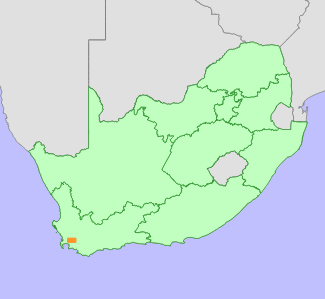|
Scientific Name | Erica alexandri Guthrie & Bolus subsp. alexandri |
Higher Classification | Dicotyledons |
Family | ERICACEAE |
National Status |
Status and Criteria | Critically Endangered A4ac |
Assessment Date | 2012/08/07 |
Assessor(s) | R.C. Turner, L. von Staden & I. Ebrahim |
Justification | Fewer than 1000 plants remain, scattered across four small fragments within an area of 5 km² after more than 80% of this taxon's habitat has been transformed for crop cultivation, urban expansion, timber plantations and degraded due to alien invasive plant infestations. The population has declined by an estimated 78% in the past 10 years, and is expected to exceed 80% within the next 10-20 years (generation length 15-20 years), due to ongoing habitat loss and degradation. It is therefore listed as Critically Endangered under criterion A. |
Distribution |
Endemism | South African endemic |
Provincial distribution | Western Cape |
Range | This species is distributed from Paarl to Franschhoek. |
Habitat and Ecology |
Major system | Terrestrial |
Major habitats | Swartland Alluvium Fynbos |
Description | Plants grow in wetlands on sandy flats at foot of mountains. |
Threats |
| Erica alexandri subsp. alexandri is endemic to Critically Endangered Swartland Alluvium Fynbos, which extends from the flats below Paarl Mountain (where the type specimen was presumably collected) to Franschhoek. Within this area, this vegetation type is already more than 80% transformed, as a result of expanding crop cultivation, urban expansion, and forestry plantations, and only small, severely degraded fragments remain. These are under severe ongoing development pressure, are infested with alien invasive plants and are infrequently burnt - this reseeding species requires fire to regenerate.
Plants are currently surviving on 3-4 small fragments. By far the largest clump of plants occur on the edge of a wetland at a site that was formerly under pine plantations. When the pines were felled and the site burnt in 2002-2003, there was significant regeneration of plants, and the area was declared a World Heritage Site (E.G.H. Oliver pers. comm. 2005) and was proposed to be brought under the management of the local conservation authority. However, this transfer has not yet occurred and in the mean time the site has continually degraded and the number of Erica alexandri plants declined significantly. Alien invasive plants have densely invaded the area, and the wetland has nearly dried up. The forestry company who owns the land now wants to replant the site with pines (I. Ebrahim pers. comm. 2012).
A smaller clump of plants were found about 1 km to the west of this site in 2008, at a site earmarked for low-cost housing development. Another small clump of plants, found in 2006, occurs on privately owned land severely infested with alien invasive plants, and where the landowner has obtained a permit to do sand mining, and one plant was found in 2008 at a development site for a proposed housing estate. |
Population |
Erica alexandri subsp. alexandri most probably formerly consisted of a single, large subpopulation, extending all along the alluvial flats between Paarl and Franschhoek, however, due to over 80% habitat loss, only a few, small clumps of plants remain on fragments of natural vegetation. This species is critically dependent on fire for regeneration, and after one site, a wetland in the Wemmershoek area near Franschhoek was burnt in 2002-2003, about 3000 plants were recorded at the site in 2006 (R.C. Turner pers. obs.), however, due to ongoing neglect of the site, these have now declined to fewer than 500 plants (80% decline, I. Ebrahim pers. comm. 2012), and is likely to be lost completely if plans to replant the site with pines go ahead. A nearby small clump of 100 plants are threatened by housing development, and another of between 50-100 plants are likely to be lost to sand mining. A single plant was found at a housing estate development site in 2008. Based on known population decline that has already occurred in the past 10 years, and due to the fact that none of the four locations are currently protected and there is ongoing pressure on remaining habitat, it is estimated that population reduction will exceed 80% within the next 10-20 years.
|
Population trend | Decreasing |
Assessment History |
Taxon assessed |
Status and Criteria |
Citation/Red List version | | Erica alexandri Guthrie & Bolus subsp. alexandri | CR B1ab(i,ii,iii,iv,v)+B2ab(i,ii,iii,iv,v) | Raimondo et al. (2009) | | Erica alexandri Guthrie & Bolus subsp. alexandri | Endangered | Hilton-Taylor (1996) | |
Bibliography |
Goldblatt, P. and Manning, J.C. 2000. Cape Plants: A conspectus of the Cape Flora of South Africa. Strelitzia 9. National Botanical Institute, Cape Town.
Hilton-Taylor, C. 1996. Red data list of southern African plants. Strelitzia 4. South African National Botanical Institute, Pretoria.
Oliver, E.G.H. and Oliver, I.M. 1994. Studies in the Ericoideae (Ericaceae). XIV. Notes on the genus Erica. Bothalia 24(1):25-30.
Raimondo, D., von Staden, L., Foden, W., Victor, J.E., Helme, N.A., Turner, R.C., Kamundi, D.A. and Manyama, P.A. 2009. Red List of South African Plants. Strelitzia 25. South African National Biodiversity Institute, Pretoria.
|
Citation |
| Turner, R.C., von Staden, L. & Ebrahim, I. 2012. Erica alexandri Guthrie & Bolus subsp. alexandri. National Assessment: Red List of South African Plants version 2024.1. Accessed on 2025/10/24 |
 Comment on this assessment
Comment on this assessment


